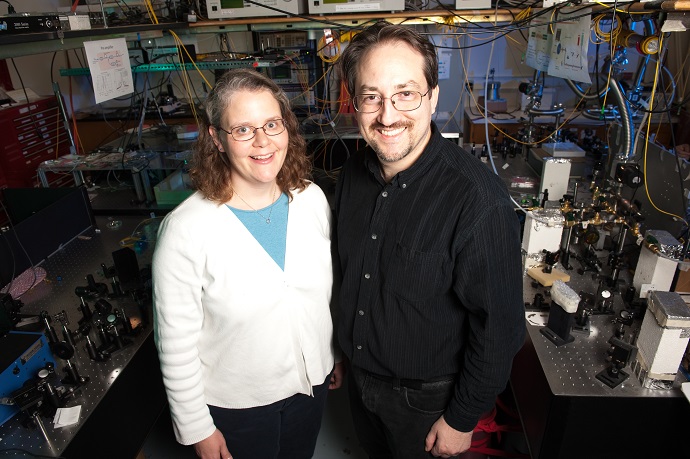June 8, 2016
MANHATTAN — A new class of lasers developed by a team that included physics researchers at Kansas State University could help scientists measure distances to faraway targets, identify the presence of certain gases in the atmosphere and send images of the earth from space.
These energy-efficient lasers also are portable, produce light at difficult-to-reach wavelengths and have the potential to scale to high-powered versions.
The new lasers were invented by Brian Washburn and Kristan Corwin, both associate professors of physics at Kansas State University's College of Arts & Sciences, along with Andrew Jones, a May 2012 doctoral graduate in physics, and Rajesh Kadel, a May 2014 doctoral graduate in physics. Other contributors include three University of New Mexico physics and astronomy researchers: Wolfgang Rudolf, a Regents professor and department chair, Vasudevan Nampoothiri, a research assistant professor, and Amarin Ratanavis, a doctoral student; and John Zavada, a Virginia-based optic and photonic physicist who brought them all together.
The new lasers are fiber-based and use various molecular gases to produce light. They differ from traditional glass-tube lasers, which are large and bulky, and have mirrors to reflect the light. But the novel lasers use a hollow fiber with a honeycomb structure to hold gas and to guide light. This optical fiber is filled with a molecular gas, such as hydrogen cyanide or acetylene. Another laser excites the gas and causes a molecule of the excited gas to spontaneously emit light. Other molecules in the gas quickly follow suit, which results in laser light.
"By putting the gas in a hollow core, we can have really high intensities of light without having to put such high amounts of power into the laser," Corwin said. "If you had a glass tube of that size and put light in it, the light would escape through the sides. It's actually the structure that makes it work."
The structure also allows for portability. In contrast to traditional lasers, which are fragile and cumbersome to move, the researchers' more durable fiber laser is about the thickness of a single strand of hair and can wrap around itself for compact storage and transportation.
"The smallness is nice," Washburn said. "You can wrap up the coil like a string."
The invention process began when Zavada brought Washburn and Corwin, who already had expertise putting gas into hollow fibers, together with Rudolph and Nampoothiri, who were skilled in making optically pumped gas lasers.
"We thought hard about how this would all work together, and after about a year and a half, we came up with this," Corwin said.
The inventors' lasers use gas, which was the popular method before manufacturers moved to solid-state materials. For example, up until the mid-1990s, grocery store scanners were gas lasers, while present-day grocery scanners use solid-state lasers.
"What we've done is use an old-school technology medium in a new-school package," Washburn said.
The researchers are continuing to study and improve the lasers using fibers from Fetah Benabid at Xlim in Limoges, France, with funding from the U.S. Air Force Office of Scientific Research and the U.S. Air Force Research Laboratory.
Jones and Kadel are now working in industry, both in laser research and design. Jones is a senior optical engineer for Lockheed-Martin, and Kadel is an optical engineer at Calmar Laser.
U.S. patent No. 9,106,055 for Gas Filled Hollow Fiber was issued in 2015 and is shared by the Kansas State University Research Foundation, a nonprofit corporation responsible for managing technology transfer activities at the university; STC.UNM at the University of New Mexico; and Zavada.














